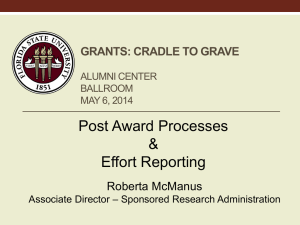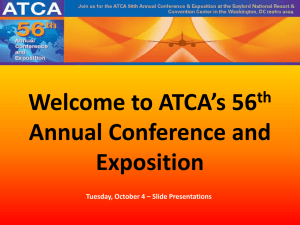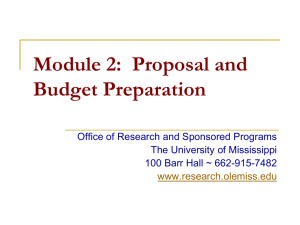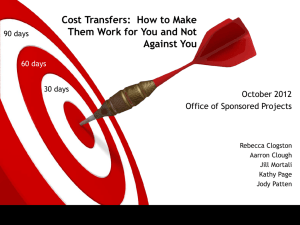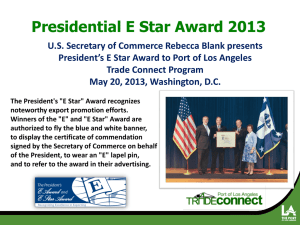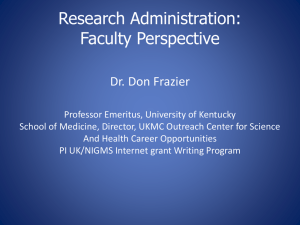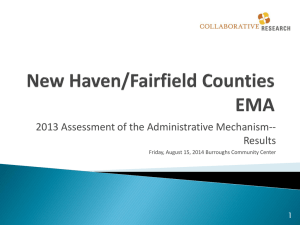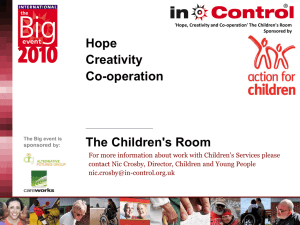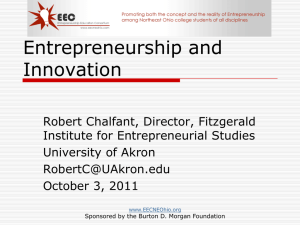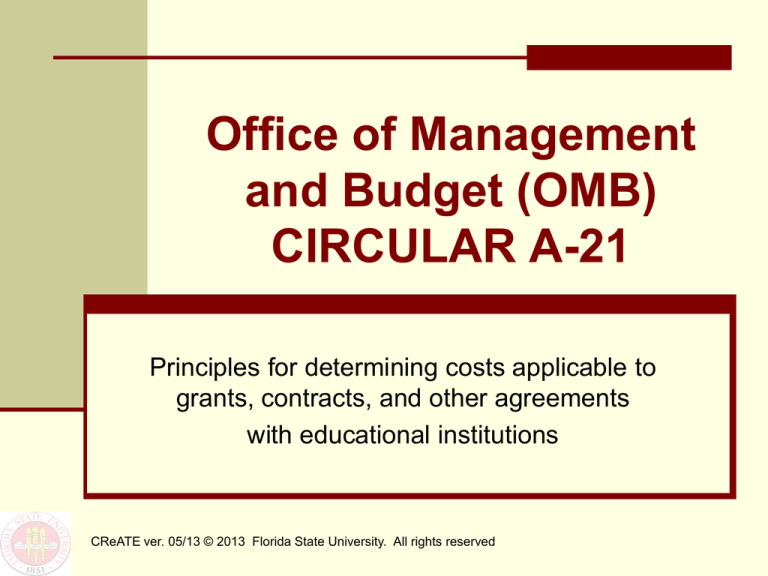
Office of Management
and Budget (OMB)
CIRCULAR A-21
Principles for determining costs applicable to
grants, contracts, and other agreements
with educational institutions
CReATE ver. 05/13 © 2013 Florida State University. All rights reserved
OMB Circular A-21
THE PRIMARY ACCOUNTING REFERENCE FOR
FEDERAL SPONSORED AGREEMENTS
2
DHHS Audit Experience
Entrance Conference December 6, 2010
Fieldwork December 6, 2010 – May 26, 2011
Exit Conference May 27, 2011
Draft report received from OIG November 16, 2011
Response to draft submitted January 31, 2012
Final report issued by DHHS OIG July 19, 2012
Response to final report submitted October 9, 2012
Audit Resolution Phase
Awaiting DHHS decision on what division will negotiate
the final resolution with FSU
3
A-21: A Brief History
Originally issued in 1958
Significant changes made in 1996:
Raised threshold for capitalizing equipment to $5,000
Established use of Facilities & Administration (F&A)
rate(s) in effect at start of sponsored agreement over
life of agreement
Incorporated four Cost Accounting Standards (CAS)
Required educational institutions to submit a Disclosure
Statement (DS-2) regarding cost accounting practices
Draft Super Circular issued
Combines 7 circulars into one document
COGR has issued draft response
Responses to OMB due June 2, 2013
4
Why talk about OMB Circular A-21?
SRS and SRAS employees need to
refer to OMB Circulars A-21 and A110 (next presentation) on a daily
basis
Every decision on federally funded
agreements is guided by these
pronouncements
5
A-21: Applicability
To all research and development, training
and other work funded with federal funds at
educational institutions
Principles used only as guide in pricing of
fixed price or lump sum agreements
The Proposal budget on a fixed price
agreement is subject to audit for compliance
with A-21
Basis for requiring a detailed budget on a fixed
price award
Actual expenditures on a fixed price
agreement are not subject to audit
6
Major Functions
Instruction
Teaching and training activities
Not research training
Departmental research
Not organized research
Not separately budgeted
Not considered major function
Organized Research
Research and development activities
Separately budgeted
Includes research training
7
Major Functions
Other Sponsored Activities
Programs and projects that are service oriented
Not instruction or organized research
Examples
Head Start program
WFSU activities
Other Institutional Activities
All activities not otherwise classified
Dorms
Dining facilities
F&A costs
Specialized Service Facilities
8
A-21: Direct Costs
Can be identified specifically with a particular
sponsored project, an instructional activity, or any other
institutional activity, or can be directly assigned to
such activities relatively easily with a high degree of
accuracy
Where an institution treats a particular type of cost as
direct cost of sponsored agreements, all costs
incurred for same purpose in like circumstances
must be treated as direct costs of all institutional
activities
9
Direct Costs – Personnel Costs
Salaries and fringe benefits
Faculty and other non administrative/clerical and
student employees working on the sponsored
project
Job titles (not all inclusive)
Researcher
Lab Assistant/Researcher
Graduate Research Assistant
10
Direct Costs – Non Personnel
Other direct costs:
Animals
Animal care
Audio-visual supplies (chemicals, glassware, etc.)
Books and periodicals
Specialized & technical svcs
Consulting services
Lab equipment & equipment maintenance
Computer equipment and supplies - research purpose
Laboratory supplies
Long distance telephone
Publication costs
Rent & other off-campus facilities costs
Scientific reprints
Subawards
Travel
Tuition
11
Facilities & Administrative (F&A) Costs
Costs incurred for common or joint objectives
and, therefore, cannot be identified readily
and specifically with a particular sponsored
project, instructional activity, or any other
institutional activity
12
Computer Purchases
Deemed to be “general purpose equipment”
per A-21 J18a(4)
Generally unallowable as direct charges
(J18b(1))
Requires approval in advance by awarding
agency
Refer to guidance issued in June 2012
http://www.research.fsu.edu/contractsgra
nts/documents/ITguide.pdf
Included in proposal – adequate justification
Not included in proposal – seek approval
Prior to purchase
13
A-21: Cost Accounting Standards
CAS 501- Consistency in estimating,
accumulating and reporting costs
Basis used in estimating costs in proposal
budget, charging costs to sponsored
agreement and reporting costs to sponsor
must be consistent with one another
CAS 502- Consistency in allocating costs
incurred for same purpose
All costs incurred for same purpose, in
like circumstances, are either direct
costs only or indirect costs only
14
A-21: Cost Accounting Standards
CAS 505 - Accounting for unallowable costs
Unallowable costs must be identified in
accounting system or identifiable from
departmental records
CAS 506 - Cost accounting period
FSU’s fiscal year – July 1, xxxx – June 30, xxxx
15
A-21: Disclosure Statement
Large educational institutions
$25 million per year or more in federally funded awards
To cognitive agency (DHHS) for review and approval
FSU Disclosure Statement (DS-2) History
Submitted – June 1998
FSU submitted revisions – September 2006, April 2009
and January 2010
Received approval March 2010
Revised capitalization threshold to $5,000 approved with
most recent negotiated F&A rate agreement in July 2012
16
Key FSU Practices
Accounting system description: cash
basis
Cost accounting period: 7/1 to 6/30
Capitalization of non-expendable
tangible personal property
$5,000/useful life greater than one year
Treatment of costs – direct and
indirect declared
17
FSU Policies Related to DS-2
Issued a policy on Direct and Indirect Costs
of Sponsored Agreements
Issued a policy on Cost Sharing
Issued a policy on Unallowable Costs of
Federally Sponsored Projects
Policies can be found on Sponsored Research
Web site ( http://www.research.fsu.edu )
18
A-21 Cost Principles
Allowability Factors
Reasonableness
Allocability
Consistency of treatment
Conformity to limitations or
exclusions
19
Reasonableness
1 - Reasonable
Prudent person would have paid the stated
amount for the goods/services
Cost necessary to accomplish objectives of
sponsored award
Restraints or requirements imposed by arm’slength bargaining/Federal & State
laws/sponsored award terms & conditions
Due prudence
Consistent with institutional policies
20
Examples
Researcher requesting reimbursement for
purchase of 1,000 pipette tips from vendor with no
price agreement with FSU and paid for with
personal credit card. Price paid $.50/tip vs.
eMarket vendor cost = $.10/tip.
Travel by researcher to Washington to discuss
technical issue on sponsored project with
sponsoring agency’s program manager.
Researcher followed FSU travel rules.
Lunch for researcher and department chair at
Governor’s Club to discuss courses for next
semester.
21
Answers
Not reasonable – did not follow
institutional policies
Reasonable – meets criteria
Not reasonable – not research
purpose
22
Allocability
2 - Allocable
Goods or services involved can be charged
in accordance with relative benefits received
Identifiable to a sponsored award
Incurred solely to advance work under
sponsored agreement
Benefits more than one sponsored
project or other institutional activity, the
cost must be shared
Necessary for operation of sponsored
and/or other institutional activity
23
Allocability
Equipment specifically authorized under
sponsored agreement, is assignable to
sponsored agreement regardless of any use
that may subsequently be made
24
Allocability - Lab Manager
In multi award lab general duties must be
allocated across awards on a reasonable
basis. Examples,
Training of students, other researchers in lab
protocols and procedures
Animal care that may not be specific to one project
Performing or supervising others in the preparation
of experiments, equipment maintenance, and lab
inventory
Staying abreast of animal care developments
25
Example – Lab Manager
Dr. Gold performs retinal research with
zebra fish on 2 R01 NIH awards and
conducts some departmental research.
Ms. Seminole trains all students in lab
techniques and protocols (10%), orders
supplies for the lab (5%), cares for the fish
colonies (25%), performs experiments
assigned by Dr. Gold (60%)
How allocate?
26
Answer
40% general duties
Both R01 grants
Non sponsored source for the
departmental research
% as determined by Dr. Gold
60% directly related to performing
experiments allocated (Dr. Gold estimate)
27
Example – Salary Charges
Research associate’s salary for month of
July 2008 charged to sponsored project
for actual work performed on project in
January 2008
Research associate’s effort in July 2008
did not pertain to sponsored project
Sponsored project period was 1/1/08 to
12/31/08
28
Answer
Charge is unallowable because research
associate’s effort in July did not benefit
sponsored project
This practice is referred to as “cost
substitution” and does not conform to A-21
requirements
29
Allocability – General Lab Supplies
In multi award lab general lab supplies (pipettes,
gloves, etc.) must be allocated across awards on a
reasonable basis. Considerations,
Can/will items be used by all awards in lab?
Specialized items?
Is item used for general lab upkeep?
What are the lab supply and ordering practices?
Is there non sponsored research occurring in the lab?
Length of awards using items?
What type of experiments are being conducted?
30
Example – General Lab Supplies
Dr. Tomahawk performs sense of smell research with
rats and has 1 R01 NIH and 2 NSF grants all in the
same lab. The aims do not overlap but all of the
grants use similar research techniques and
equipment.
The lab manager requests for purchase 5000 pipette
tips ($500), 300 glass test tubes ($150) and 1
gustometer ($6,000) that will be used only on the R01
award.
How should the items purchased be charged to each
award?
31
Answer 1
The pipette tips and test tubes should be
allocated to all awards:
PI estimate % of usage on each award
Charge 100% of gustometer to the R01
award.
32
Answer 2
Each researcher works on only 1 award and
requests supplies from lab manager monthly:
Grad Student A (R01) 2000 pipette tips =
$200
Grad Student B (NSF A) 2000 pipette tips 200
test tubes = $300
Grad Student C (NSF B) 1000 pipette tips and
100 test tubes = $150
Charge 100% of gustometer to the R01
award = $6,000
33
Allocability – Service Agreements
In multi award lab service agreements for equipment
must be allocated across awards on a reasonable basis.
Considerations,
When was the equipment purchased? Source of
funding? Source active?
What is the equipment used for? What projects require
the use of the equipment for the svc agmt period
Is there non sponsored research occurring in the lab?
Length of awards using items?
What type of experiments are being conducted?
34
Example – Service Agreement
Dr. Tomahawk performs sense of smell research with
rats and has 1 R01 NIH (ends 6/30/2012) and 2 NSF
grants (both end 12/31/2013) all in the same lab. The
aims do not overlap but all of the grants use similar
research techniques and equipment.
There are 5 centrifuges in the lab. The R01 uses the
3 large centrifuges and the 2 NSF awards use the 2
smaller ones with equal usage.
Each service agreement costs $500 for period
1/1/2012-12/31/2012
How should the service agreements’ costs be
charged to each award?
35
Answer
R01 = $750
NSF A = $500
NSF B = $500
Non sponsored source = $750
Total = $2,500
Note rotation among awards generally not
acceptable method
36
Example – Equipment
Dr. Garnett purchased a microscope costing
$10,000 on an NSF-funded project during last
month of a one-year grant period. The
microscope has a 5 year life.
The microscope was included in the budget
approved by the agency.
The equipment was required to complete the
analysis phase of research.
37
Answer
Charge for this equipment is allowable as it
was purchased during grant period.
Even though equipment had five year useful
life and was used only one month of grant
period, it conforms to A-21 provision
“specifically authorized in grant… regardless of
subsequent use”.
38
Allocability – Cost Transfer Policy
Effective April 1, 2008; revised July 1, 2010
http://www.research.fsu.edu/contractsgrants/
documents/costtranspolicy.pdf
Expenditure transfers to or between
sponsored projects
Red flags
Frequent transfers
Transfers close to end of project
Inadequate documentation to support transfer
39
Cost Transfers
Improper cost transfers
Cover overruns
Spend available balance close to end of project
Transfer of unallowable cost from one project to
another
Circumvention of award limitation/restriction
Charge costs to one project that belong to an
award not yet executed
Advance policy enacted for this reason!
40
Cost Transfers
Allowable transfers
Correct erroneous charge
Allocate portion of charge that applies to the project (e.g.
split purchases)
Cost Transfer Justification Form at
http://www.research.fsu.edu/contractsgrants/forms.html
Must be received by SRAS as follows:
Within 90 calendar days from the end of the month in
which the error occurred (personnel and non-personnel)
Retroactive Distribution of Funding
Moving salary between or onto projects reallocating
original ePAF distribution as a result of the effort
certified is acceptable justification for salary cost
transfers
41
Cost Transfers
Cost transfers not received by SRAS by deadline
will only be approved in extenuating
circumstances, which does not include:
Absences of PI or project administrators
Non qualified staff
Shortage of staff
SRAS Compliance Committee reviews on
weekly basis
SRAS Director approves >$25,000 or > 90 days
Monthly reconciliations needed to detect and
correct errors within established timeframes
Controller’s Office offers training:
BTFA03 - General Ledger Reconciliation
42
Cost Transfers
Justifications – what not to say!
“Charged to NSF grant waiting for NIH
grant to get set up.”
“Reconciliations were not performed for 6
months because of support staff turnover.”
“There are funds left on Project Aaa and we
want to spend the balance. We charged the
costs to Project Bee but now that there is
funding left so we need to move the costs.”
43
Example – Cost Transfers
A graduate assistant worked and was paid 50% on
grant from US Dept. of Agriculture (USDA) and 50%
on grant from National Science Foundation (NSF).
Each grant was charged 50% of tuition. Since USDA
policy does not permit charges for tuition, the PI
requested that the tuition charge be transferred from
USDA account to NSF account.
Would you approve this cost transfer?? Why or Why
not??
44
Answer
Tuition charge transferred to NSF
account is unallowable because
Charge to NSF grant (now at 100%) was
not proportional to effort devoted to NSF
grant (50%)
Transfer was made to avoid restriction of
USDA policy.
45
Example – Cost Transfers
At the start of Fall 2011 semester, Dr. Nole
was appointed as follows:
E&G funding = 65%
NIH P01 award = 20%
NSF award = 15%
Dr. Nole certified his Fall 2011 effort report
as follows:
E&G funding = 65%
NIH P01 award = 15% (Error occurred <20%
paid)
NSF award = 20%
How do we resolve the effort error??
46
Answer
An RDF is required to move 5% from the
NIH to the NSF award.
Allowable because it “trues” up to actual
Meets time criterion because as a result of
actual effort
Requesting the PI to change his/her effort
certification “to get rid of the error” IS NOT
the solution!!!!
47
Cost Transfers - NIH Policy
The NIH Grants Policy Statement
Cost Transfers to NIH grants by grantees…should be
accomplished within 90 days…
Transfers must be supported by documentation that fully
explains how error occurred and certification of
correctness of new charge by responsible University
official …
Stating that transfer was made “to correct error” or “to
transfer to correct project” is not sufficient.
Transfers of costs solely to cover cost overruns are not
allowable.
48
Cost Transfers - NIH policy
Grantee’s must maintain prescribed documentation of
cost transfers and must make it available for audit…
Frequent errors in recording costs may indicate need
for accounting system improvements and/or
enhanced internal controls.
If such errors occur, grantees are encouraged to
evaluate need for improvements and to make
whatever improvements are deemed necessary to
prevent reoccurrence.
NIH also may require a grantee to take corrective
action by imposing additional terms and conditions on
an award.
49
Allocation & Documentation
Standard - Internal Controls
An institution's financial
management system must provide
that no one person has complete
control over all aspects of a
financial transaction
50
Example – Internal Control
PI (also department chair) prepares TAR for
PI’s travel and signs as traveler, PI and PI’s
supervisor.
PI prepares travel reimbursement and
reconciles departmental accounting records.
Is this appropriate?
51
Answer
No
This would be an unacceptable practice and
would not meet the criteria of A-21
FSU’s signature requirements on accounting
documents prevents an internal control
violation such as this from occurring
52
Allocation & Documentation
Standard - Applicable Credits
Applicable credits must be applied to related
expenditures
Typical examples of applicable credits are:
purchase discounts, rebates, or allowances;
and adjustments of overpayments or
erroneous charges
53
Example – Applicable Credits
Lab equipment was purchased in July 2011
for $2,000 on Dr. Gold’s R01 grant that ended
September 30, 2011.
In September 2011 it was discovered that the
vendor overcharged for the equipment by
$500.
A credit was received and the department
charged the credit to Dr. Gold’s P01 award
because it was the only award open.
Is this appropriate?
54
Answer
The $500 credit should have been applied
against Dr. Gold’s R01 grant that was closed
SRAS is supposed to receive all refund
checks when related to sponsored
projects
Department submits refund form that includes
chartfield information where the original
charge was posted
SRAS verifies chartfields to ensure the
appropriate sponsored project is credited
even if project is closed
55
Limitations on Allowance of Costs
Sponsored agreements may be subject to
statutory requirements that limit allowance of
costs
When maximum amount allowable under
limitation is less than total amount allowed in
A-21, amount not recoverable under
sponsored agreement may not be charged to
other sponsored agreements
Must be funded by a non-sponsored source of
funds
56
Example – Limitations
PI had an NIH grant and devoted 50%
effort to it during month of August 2005
PI’s annual salary rate was $190,000/yr,
$15,834/mo
Grant period was Feb. 05 to Jan. 06
Grant was charged $7,917 (50% of
$15,834) for PI’s August salary
NIH had salary rate cap of $180,100/yr or
$15,008/mo for 2005
[Current 2012 NIH Salary Cap is $179,700]
57
Answer
Costs of $413 are unallowable because the
salary charged to the grant exceeded the
sponsoring agency’s “rate of pay” limitation
Maximum amount chargeable to grant for 50%
effort was $7,504 (50% of $15,008)
The grant should have been charged $7,504 for
effort and amount in excess of the NIH cap
($7,917-$7,504=$413) charged to E&G or another
unrestricted funding source
[Current (2012) NIH Salary Cap is $179,700]
58
Cost Accounting Standard 502
CAS 502- Consistency in allocating costs
incurred for same purpose
All costs incurred for same purpose, in
like circumstances, are either direct
costs only or indirect costs only
59
Cost Accounting Standard (CAS) Exemption
Allowable to charge Administrative costs directly to
the sponsored project
Exceptional Circumstances
Must be approved in advance of charges normally
classified as administrative being charged directly to
a project
Try to handle at proposal stage
60
Exceptional Circumstances –
Definition
If the nature of a sponsored project
requires an extensive amount of
administrative and/or clerical support or
goods/services significantly greater
than the routine level provided by an
academic department, then the effort is
deemed an exceptional circumstance and
such costs can be accounted for as direct
61
Exceptional Circumstances –
Other conditions required
Be specifically identifiable to a particular
sponsored project
Meet A-21 requirements for
reasonableness, allowability and allocability
Be specified in the proposal budget and
approved by the sponsoring agency
62
Exceptional Circumstances Documentation Requirements
CAS Form
Complete and submit to SRS
Salaries:
Title(s), FTE, and salary amount(s) for the
clerical/administrative position(s)
What it is about the scope of the project that
requires this extensive effort
Other Costs (office supplies, memberships,
postage, local telephone, cell phones, etc.):
Description and cost of supplies/services
What it is about the scope of the project that
requires these goods/services to further the
research or other sponsored activity
63
Exceptional circumstances –
Examples
Large, complex programs, such as Clinical
Research Centers, program projects, environmental
research & engineering research centers & projects
that entail assembling & managing teams of
investigators from a number of institutions
Projects which involve extensive data
accumulation, analysis & data entry, surveying,
tabulation, cataloging, searching literature, & reporting,
such as epidemiological studies & clinical records
Projects that require making travel & meeting
arrangements for large numbers of participants,
such as conferences and seminars
64
Exceptional circumstances –
Examples (cont’d)
Projects whose principal focus is the preparation &
production of manuals & large reports, books &
monographs (excluding routine progress & technical
reports).
Projects that are geographically inaccessible to
normal departmental administrative services, such as
seagoing research vessels, radio astronomy projects, &
other research field sites that are remote from campus.
Individual projects requiring project-specific database
management; individualized graphics or manuscript
preparation; human or animal protocols; and multiple
project-related investigator coordination and
communications.
65
Example - CAS Exemption
Professor Washington is awarded a $5,000,000 (5 year)
grant to coordinate Medical teams from all Florida
universities to train medical professionals on new
geriatric caretaking techniques. Training meetings are to
be conducted 4 times per year at different locations
across the state.
Professor Washington is requesting a CAS exemption for
two administrative positions to coordinate the training
teams, organize training conferences including travel
arrangements for the University teams and to do
outreach to the bring/entice the professionals to
participate in the training. These positions were included
in the budget approved by the agency.
Approve or Deny????
66
Example - CAS Exemption
Professor Adams is awarded a $50,000 (1 year)
grant to write and produce training materials for the
US Dept of Education’s early childhood education
program. The materials will be used to train
childcare professionals.
Professor Adams is requesting a CAS exemption to
charge $25,000 for printing/reproduction of 1,000
manuals. These costs were included in the budget
approved by the agency.
Approve or Deny????
67
F&A Costs and Rate Agreement
F&A costs defined as those incurred for common or joint objectives
and, therefore, cannot be identified readily and specifically with a
particular sponsored project, instructional activity, or any other
institutional activity
F&A a.k.a. Overhead a.k.a. Indirect Costs
FSU negotiates F&A rates with the FSU’s cognitive agency –
Department of Health and Human Services (DHHS) Division of Cost
Allocation (DCA)
Negotiations culminate in a Rate Agreement at
http://www.research.fsu.edu/contractsgrants/documents/rateagreemen
t.pdf
68
F&A Cost Categories
Facilities
Building and Equipment Depreciation
Interest
Operations and Maintenance
Library
Administration
General Administration
Departmental Administration
Sponsored Projects Administration
Student Services Administration
69
F&A Rate Development
Negotiating cycle is every four years
Prepare and submit F&A cost allocation proposal
FSU’s current rates negotiated July 2012
Effective through June 30, 2016
Objective of the F&A allocation proposal is to aggregate
and distribute F&A costs to the major functions of
the institution in proportions reasonably consistent
with the nature and extent of their use
70
F&A Rate Application
Multiple Rates are allowed:
On Campus – comprised of both facility and administrative
costs
Off Campus – comprised of administrative costs only (26%)
Separate functions – rates for instruction, organized
research, and other sponsored activity
Separate rate for NHMFL at FSU
The actual charge to the sponsored project is
calculated by multiplying the F&A rate by the
distribution base
71
Facilities & Administrative Rates
Organized Research
On Campus 51.3% (52% effective July 1, 2014)
Off Campus 26.0%
National High Magnetic Field Lab (NHMFL) Rate
On Campus 70.0%
Off Campus 26.0%
F&A Distribution Bases
Federal = Modified Total Direct Cost (MTDC)
Exclusions:
Equipment/capital expenditures
Patient care
Rent
Scholarships/fellowships
Subcontract amount > $25,000
Tuition Remission
State of Florida = Total Direct Costs (TDC)
Exclusion:
Tuition Remission
73
Example Calculation
Salaries
Benefits
Tuition
Materials and Supplies
Equipment
Total Direct Costs
F&A Base
F&A Rate
F&A Amount
Total Project Cost
TDC
$10,000
2,000
1,000
2,000
5,000
$20,000
$19,000
10%
1,900
$21,900
MTDC
$10,000
2,000
1,000
2,000
5,000
$20,000
$14,000
51.3%
7,182
$27,182
74
F&A Costs Recovered
The F&A costs recovered by the University from
charges made to sponsored projects are placed into
the Sponsored Research and Development (SRAD)
Fund
Presentation on the SRAD recovery and distribution
later
75
A-21: Selected Items of Cost
A-21 principles must be applied in establishing
allowability of cost, whether particular item is treated
as direct cost or indirect cost
Fifty-four specific items of costs are addressed in
section J.
Other items not specified may be allowable or
unallowable
Items specifically stated as “allowable” must
meet the “allowability principles”
76
Section J. Unallowable Costs
Public Relations
Alcoholic Beverages
Bad Debts
Commencement/Convocation
Contingencies
Entertainment
Improvements to land, buildings, or equip that increase
value or life (unless prior agency approval)
Fines/Penalties
77
Section J. Unallowable Costs
Goods or Services for personal use
Lobbying
Losses on other awards
Memberships
Preagreement/pre award (unless approved by agency)
Student Activity Fees (unless specifically provided for
in award)
78
A-21: Certification of Charges/Payment
Required on financial reports and
payment requests
Reads essentially as follows: "I certify
that all expenditures reported (or
payment requested) are for appropriate
purposes and in accordance with the
provisions of the application and award
documents.“
SRAS requests PI signature on final
expenditure report or invoice
79
QUESTIONS
80

